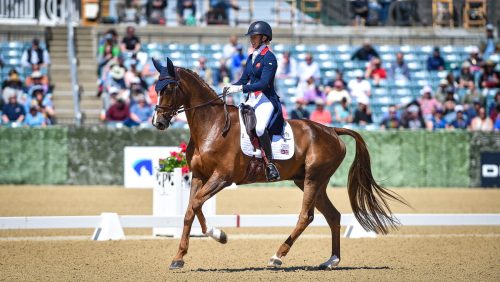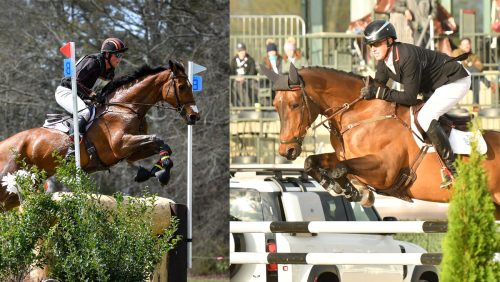When Rebecca Diesinger, from Coopersburg, Pa., first saw Dollar Spot in September 1999, the then 8-year-old, Thoroughbred gelding was a disgusting mass of skin, bones and fungus. The race horse rescue organization Lost and Found from York, Pa., had saved the gelding from the slaughter truck and sent him to Diesinger’s trainer and employer, Jane Corey, who often rehabilitated rescue horses either for resale or for use in the lesson program at her Pleasant Hollow Farm.
Corey gave Diesinger, a fledgling low-level eventer who had ridden in her first beginner novice event two years earlier, the ride on “Dollar.” “I just wanted her to bring Dollar along to the point where he’d be a safe lesson horse,” said Corey.
So Corey paid Lost and Found an $800 adoption fee for the Maryland-bred gelding by Electric Blue and helped Diesinger nurse him back to health.
Diesinger, now 25, and Dollar began competing at novice and training level later that season and moved up to preliminary during 2001. Dollar often jumped in an unorthodox fashion, leaving strides out with abandon. “But he was brave as could be and never blinked an eye at anything,” recalled Corey.
During 2002, Diesinger and Dollar finished 10th in their first three-day, the Virginia CCI* in May, then moved up to intermediate and finished 39th at the Radnor Hunt CCI** (Pa.) in October. Despite the pair’s meteoric rise through the ranks, Diesinger expressed only a cautious optimism about their future.
“Dollar had an old injury from his racing days, and we really didn’t have any idea how far he would go,” Diesinger said. “It was simply a matter of, well, we did preliminary so I guess we should try intermediate. I had never competed at such high levels, but Dollar did so well, there seemed no reason not to go on with him.”
Corey, who had campaigned her own Tuppence at advanced in the 1980s, recognized the pair’s potential. “Rebecca is a great student; she’s focused and works incredibly hard,” Corey said. “We kept Dollar at preliminary a long time so he could get his bearings. As the questions came up, then got more difficult as he progressed, he just kept answering them.”
Corey enlisted the help of her long-time trainer and friend, Bruce Davidson, for additional jumping help as Diesinger and Dollar continued to climb the ranks.
The fairy tale continued to unfold when, in the spring of 2003, the pair placed fifth in their first advanced outing at Fair Hill International Horse Trials (Md.).
But Dollar abscessed in the summer, causing him to miss most of the season. Then, returning to advanced competition at Plantation Field (Pa.) in September, Dollar badly twisted an ankle.
“That’s the only time he ever stopped,” said Diesinger. “We knew something was really wrong.”
Although Dollar returned to work in the spring, Corey and Diesinger opted not to compete him until the Stuart CIC** (N.Y.) in July of 2004. “We just held our breath that he’d hold up,” said Diesinger.
The pair returned to advanced at Over the Walls (Mass.) in August and completed Millbrook (N.Y.) and Menfelt (Md.) before heading to the Fair Hill CCI in October.
Walking the cross-country track, Diesinger remembered thinking, “Can we really do this? Every fence on the course seemed to me like the very hardest questions we’d seen at horse trials, all combined. I was really worried about the length and terrain, too.”
Diesinger and Dollar rose to the challenge, their cross-country score marred only by 20 penalties at fence 22, a steep uphill bank to a corner. “It was my inexperience. I just didn’t think fast enough,” said Die-singer. “He tripped up the bank and couldn’t get to the corner. I should have pulled him out and gone the long way.”
Still, finishing 37th seems pretty remarkable for a horse headed for the slaughter-house and a rider who had only gone beginner novice five years before.
ADVERTISEMENT
“He’s just awesome,” Diesinger said of Dollar. “He’s just such a good, honest jumper, and he’s so good-natured. We just help each other out. I’d had dreams of going advanced, but I never thought it would happen this quickly.”
And the future? Corey and Diesinger will work out their plan for Dollar’s 2005 campaign, as always, one step at a time.
Tumble Dry
By the autumn of 2002, a Thoroughbred gelding named Tumble Dry had already made dreams come true for 18-year-old Jenna Schildmier from Greenfield, Ind.
Schildmier and “Obie” had represented Area VIII at that summer’s North American Young Riders Championships in Illinois. The pair jumped a double-clear cross-country round at their first two-star, although they had to withdraw before show jumping because of a minor injury.
“Getting to Young Riders had always been my goal, and Obie made it happen for us. He was just so fantastic on that course, I knew big things were in store for his future,” Schildmier said.
But when Schildmier went to feed Obie at her parents’ farm one September morning, she knew something was wrong when he didn’t greet her at the pasture gate. She brought the then 14-year-old gelding into the barn and checked his legs; he spooked, fell down, and couldn’t get back up. Schildmier’s father improvised a ramp so they could drag the gelding into their trailer and ship him to the renowned Rood and Riddle veterinary clinic in Kentucky.
“He fought to get up the whole way,” Schildmier said of the three-hour trailer ride. “Once we get there, it took us an hour to get him off the trailer.”
The vets fashioned a sling to keep Obie upright in his stall while they ran tests and treated him with intravenous fluids, banamine, and DMSO. Two agonizing weeks later, tests revealed that the gelding suffered from West Nile virus, a disease he had been fully vaccinated against.
Obie’s life hung in balance for four weeks at the hospital. Schildmier drove down to the clinic whenever she could and slept in her trailer to be with her horse. “He wouldn’t eat or drink unless I was there to hand feed him,” Schildmier said. “His muscles atrophied, and he lost 500 pounds.”
Although Obie pulled through, the vets pronounced with certainty that he’d remain, at best, pasture-sound for the rest of his life. “He’d done a lot for me, and I owed him a home,” said Schildmier.
But secretly, she refused to give up. “I made myself go away so I wouldn’t be tempted to push him,” she said. She accepted a two-month working student position with Ian Stark and left for Scotland with Obie safely at pasture under her parents’ watchful eye.
Meeting Obie
Schildmier grew up barrel racing until her mother decided that sport was “too risky” and steered Schildmier to a safer sport, like jumping. She began riding at event trainer Leeann Zobbe’s barn in Westfield, Ind.
In 2001, at age 17, Zobbe suggested that Schildmier take over the ride on Tumble Dry, the then 13-year-old gelding she had bought off the track and sold to client Lani Gillian. Although the horse had competed preliminary, he could be difficult.
“When I first rode him, he bolted every day, but something about him made me laugh instead of getting angry or scared,” Schildmier recalled. “Leeann had to lead me into the box at our first training level event, but when Obie flew around the course, I was so excited.”
Under Zobbe’s tutelage, the pair moved up to preliminary and finished fifth in the junior division of their first three-day, the Mid-South Three-Day Event (Ky.). Schildmier, with a little help from her parents, purchased Obie from money she’d earned training a resale project.
ADVERTISEMENT
Schildmier graduated from high school early, in December of 2001, and spent the following winter working for Peter Atkins in Ocala, Fla. “Peter made everything possible for me,” Schildmier said. “He let me work lessons off and found jobs for me in the area so I could pay my way.”
Schildmier moved Obie up to intermediate during the spring 2002 season and, with clear rounds and good ribbons at horse trials, earned a ticket to that summer’s NAYRC.
In December 2002, Schildmier returned from Scotland, then went to work for Atkins in January, bringing Obie with her. “I would ride him for 10 minutes before he’d start to slip behind, so I’d get off and put him away. Then the next day, I’d ride him 12 minutes before he’d give out. Peter urged me to send Obie home, but I just couldn’t give up,” she said.
Day by day, Obie’s strength gradually returned. Schildmier took him training level, then won a preliminary event in May. Their comeback culminated with a young riders open intermediate win at Champagne Run (Ky.) in July.
But Schildmier ran Obie sparingly after that. “I pulled out of several events when Obie didn’t feel right,” Schildmier said. “He had lost so much muscle mass during his illness, I had to be careful not to strain him as he rebuilt those muscles.”
Schildmier credits Dr. Sickels from Winchester, Ind., for guiding Obie through his reconditioning process. Despite missed events and gallops, Obie and Schildmier jumped a double-clear cross-country round to finish 21st at Radnor in 2003.
Onwards To Advanced
Schildmier, who had begun her freshman year at Indiana University-Purdue University, arranged to take courses over the Internet so she could travel to Aiken, S.C., during the winter of 2004 and work with Holly Hepp, who had coached Area VIII at the NAYRC. She and Obie finished 10th in their first advanced horse trial at Pine Top (Ga.) in March, fifth at Southern Pines (N.C.), and 10th at Plantation Field.
Returning home that summer, Obie suffered his first cross-country fall when he stumbled in the water at Hunter’s Run (Mich.) and ripped skin off his knees. After his quick recovery, Schildmier entered him advanced at Richland Park (Mich.) later that month.
“I just planned to jump a few fences and see how he felt; I was afraid he might be worried about water after his fall,” said Schildmier. But Obie jumped easily around the course, including a bounce into the water. “Obie is just such a fighter,” she said. “He never lets anything get him down.”
The pair went on to place second at Plantation Field in September, their last outing before the Fair Hill CCI.
At Fair Hill, the pair jumped clear around cross-country but incurred 24 time faults.
“I had walked the course with Phillip Dutton, and he told me, after he rode his first horse, that the footing was really tiring the horses out,” Schildmier recalled. “So I rode the course more cautiously than I intended.”
Although Schildmier wishes, in hindsight, that she’d gone faster, she was thrilled with Obie’s efforts. “Obie was just fantastic out there,” she said. “All I have to do is look at the fence, and he’s already done it. When I came to that tight turn at the coffin [Wayne’s Walls, 25ABC] all I had to do was sit up after the ditch and say, ‘There’s your fence,’ and he popped right over the last element. I just have to give him time to see what’s in front of him and he does it. He loves his job so much.”
Schildmier plans to run Obie, who will be 17 next year, in more advanced horse trials.
“I want to get really secure at this level,” she said. “I just need to be careful because of his age.”
But Schildmier believes anything is possible–after all, this horse has already beaten back the doomsayers. “Time and again, throughout his career, Obie just looks at impossible odds and still pulls it off,” she said.














